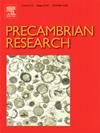罗丁尼亚超大陆分裂过程中双峰岩浆岩的裂谷变质作用
IF 3.2
2区 地球科学
Q2 GEOSCIENCES, MULTIDISCIPLINARY
引用次数: 0
摘要
识别古大陆裂谷带的超大陆破碎过程是重建超大陆的关键。然而,由于后来的地质事件的严重破坏,它仍然是一个挑战。一般来说,超大陆分裂是通过成功的大陆裂陷实现的,由岩石圈破裂发展到海底扩张。它在空间和时间上都与软流圈上升流密切相关,导致软流圈地幔通过岩石圈地幔进入大陆地壳的传导和对流热传递增强。这导致了双峰岩浆作用、高温(高t)水岩反应和高地温梯度的裂谷变质作用。尽管这些丰富的过程对研究超大陆分裂具有重要意义,但它们的作用顺序难以破译,而这些作用顺序为研究大陆裂陷过程中岩浆作用与变质作用的关系提供了有价值的线索。本文通过对华南地块北缘斜长石角闪岩和辉长岩的岩石学和年代学研究来解决这一问题。该边缘在新元古代中期从罗丁尼亚超大陆成功裂陷,适合研究与裂陷有关的过程。斜长石角闪岩和辉长岩的原岩为新元古代中期超大陆分裂时形成的双峰岩浆岩。它们首先经历了大陆冰川融水的高t热液蚀变,然后在大陆裂陷过程中再次被加热,经历了高温/低压(高t /低p)变质作用。斜长石角闪岩记录了约50°C/km的高地温梯度;在进一步的减压加热过程中,变长花岗岩中的白云母脱水形成变质红柱石,温度为80℃/km。这两种变质岩产于高地温梯度下,对应于沿伸展板块边缘和大陆裂谷带裂谷的高T/P的巴干型角闪岩相特征。双峰岩浆作用、高t热液蚀变和高t /低p变质作用在大约20 Myr的时间间隔内依次发生作用,表明双峰岩浆作用和高t /低p变质作用是超大陆分裂过程中岩石圈伸展引起的区域热异常的两种表现。因此,岩石圈伸展对裂谷变质作用起着重要的推动作用。本文章由计算机程序翻译,如有差异,请以英文原文为准。
Rift metamorphism of bimodal magmatic rocks during breakup of supercontinent Rodinia
The identification of supercontinental breakup processes in fossil continental rift zones is crucial for the reconstruction of supercontinents. However, it remains a challenge due to intensive obliteration by later geological events. In general, supercontinental breakup is realized through successful continental rifting, developing from lithospheric rupturing to seafloor spreading. It is closely associated with asthenospheric upwelling in both space and time, leading to enhancement of both conductive and advective heat transfers from the asthenospheric mantle through the lithospheric mantle into the continental crust. This gives rise to bimodal magmatism, high-temperature (high-T) water–rock reaction, and rift metamorphism at high geothermal gradients. Although such abundant processes are substantial to study supercontinental breakup, it is difficult to decipher the sequence of their operation that provides valuable clues for the relationship between magmatism and metamorphism during continental rifting. This issue is addressed by the present study of petrology and geochronology for plagioclase amphibolite and metagranite from the northern margin of the South China Block. This margin was successfully rifted from supercontinent Rodinia in the middle Neoproterozoic, making it suitable for studying rifting-related processes. The protoliths of the plagioclase amphibolite and metagranite are the bimodal magmatic rocks that formed during the supercontinental breakup in the middle Neoproterozoic. They experienced high-T hydrothermal alteration by continental glacier meltwater at first, and then were re-heated to undergo high-temperature/low-pressure (high-T/low-P) metamorphism during the continental rifting. The plagioclase amphibolites record high geothermal gradients of ca. 50 °C/km, and the metagranites preserve higher geothermal gradients of > 80 °C/km since muscovite in the metagranites was dehydrated to form metamorphic andalusite during further decompressional heating. The two kinds of metamorphic rocks were produced at the high geothermal gradients, corresponding to high T/P Buchan type amphibolite facies characteristic of continental rifting along divergent plate margins and continental rift zones. The bimodal magmatism, high-T hydrothermal alteration and high-T/low-P metamorphism would operate sequentially over an interval of approximately 20 Myr, revealing that the bimodal magmatism and the high-T/low-P metamorphism are the two manifestations of regional thermal anomaly due to lithospheric extension during the supercontinental breakup. Therefore, the lithospheric extension plays a significant role in driving the rift metamorphism.
求助全文
通过发布文献求助,成功后即可免费获取论文全文。
去求助
来源期刊

Precambrian Research
地学-地球科学综合
CiteScore
7.20
自引率
28.90%
发文量
325
审稿时长
12 months
期刊介绍:
Precambrian Research publishes studies on all aspects of the early stages of the composition, structure and evolution of the Earth and its planetary neighbours. With a focus on process-oriented and comparative studies, it covers, but is not restricted to, subjects such as:
(1) Chemical, biological, biochemical and cosmochemical evolution; the origin of life; the evolution of the oceans and atmosphere; the early fossil record; palaeobiology;
(2) Geochronology and isotope and elemental geochemistry;
(3) Precambrian mineral deposits;
(4) Geophysical aspects of the early Earth and Precambrian terrains;
(5) Nature, formation and evolution of the Precambrian lithosphere and mantle including magmatic, depositional, metamorphic and tectonic processes.
In addition, the editors particularly welcome integrated process-oriented studies that involve a combination of the above fields and comparative studies that demonstrate the effect of Precambrian evolution on Phanerozoic earth system processes.
Regional and localised studies of Precambrian phenomena are considered appropriate only when the detail and quality allow illustration of a wider process, or when significant gaps in basic knowledge of a particular area can be filled.
 求助内容:
求助内容: 应助结果提醒方式:
应助结果提醒方式:


